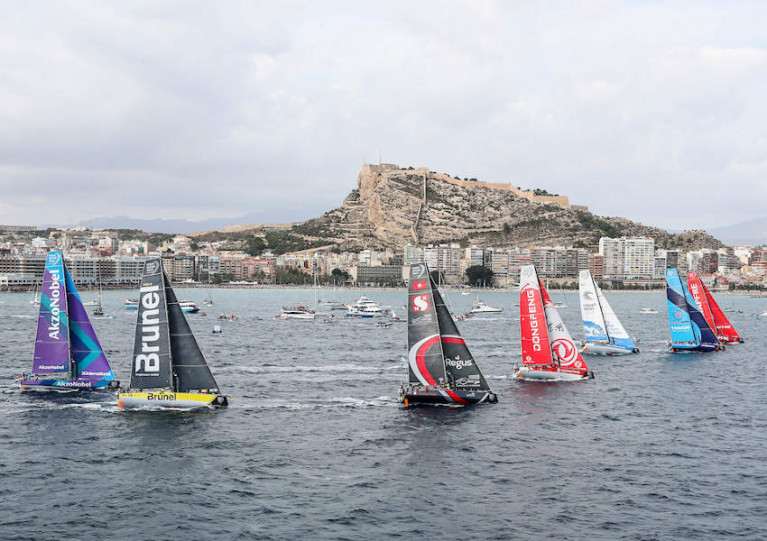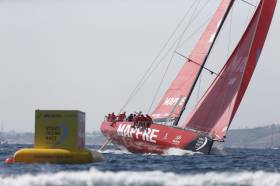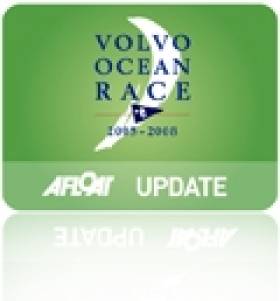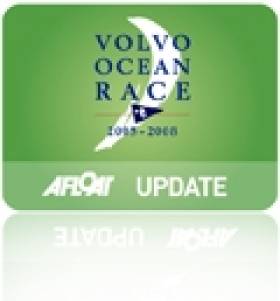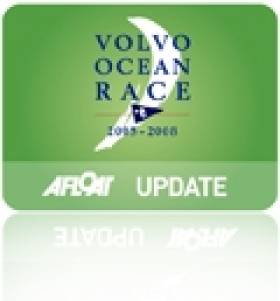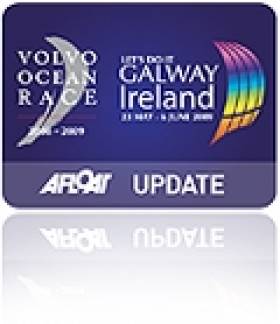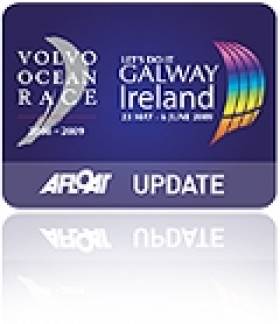Displaying items by tag: Alicante
The Ocean Race Skippers Meet the Press Ahead of Sunday’s Leg 1 Start
For some teams, the date of the skippers’ press conference sat amid an intensely hectic period as they prepared for the 32,000 mile, seven-leg, race around the world.
For others, the date for facing the world’s cameras and microphones en masse has been in their diaries for several years.
But for all, today’s (Friday 13 January) presentation of all 11 skippers across both the IMOCA and VO65 fleets signified a key stage along the road to The Ocean Race, two days ahead of the start of the 2022-23 edition of this classic and historic race on Sunday afternoon.
This is also the 50th anniversary of the event making it all the more pertinent that the 14th edition should include the longest leg in its history, 12,750 miles from Cape Town, South Africa to Itajai, Brazil. The leg is expected to take 30 days as the IMOCA fleet head deep into the Southern Ocean.
When asked, it was clear that the challenge and significance of this leg was not lost on the IMOCA skippers that are all highly accomplished.
”I’ve never done 30 days [with a crew on board] before in my life,” admitted GUYOT environnement – Team Europe (FRA/GER) co-skipper Benjamin Dutreux. Others were similarly candid.
“I think Leg 3 will be particularly hard as it will be about knowing when to slow down and how hard to push,” said 11th Hour Racing Team (USA) skipper Charlie Enright. “We may find we end up sailing at 70 percent under autopilot because that’s all the boats can handle, it’s a big question for sure. But from a spectator’s point of view the course looks like a race down to South Africa, survival to Cape Horn and a race back up to the finish.”
Yet not all the skippers agreed on which leg would be the hardest. “For sure Leg 3 will be hard as we head into the south, but three of our crew have been there before sailing alone on an IMOCA,” said Paul Meilhat of Biotherm (FRA). “For us it is Leg 1 and 2 that will be the trickiest. We have done no training together for this race, the first time we sailed as a crew was a week ago, so we will be finding out how five of us work together on the boat.”
The challenge of sailing with a full crew also delivered answers that might not have been expected. While the benefits of being able to share the physical load of managing the boat and keeping the pressure on are clear, those with solo experience highlighted the additional pressure that a full crew might bring.
 The IMOCA fleet during the In-Port Race in Alicante on Sunday 8 January | Credit: Sailing Energy/The Ocean Race
The IMOCA fleet during the In-Port Race in Alicante on Sunday 8 January | Credit: Sailing Energy/The Ocean Race
“When you sail alone you’re often not stressed as you can do things in your own time, but as a skipper you have an additional set of responsibilities to the crew, so I expect to feel more stressed at the start,” said Meilhat.
Team Holcim PRB’s (SUI) skipper Kevin Escoffier agreed: “It is easier when you sail alone, but with four others you have to think about them.”
For Dutreux, it is the mix of cultures and abilities that are on his mind ahead of the start. “We have different cultures within the crew that include a lot of strengths and what we need to do is to manage this well to get the best for the team,” he said.
For spectators and followers of the event, the impressive performance of the IMOCAs is one of the big appeals in this race, but high speeds come with risk, something that Escoffier highlighted. Developing a boat that will outperform the rest of the fleet is all part of the competition and means that teams will always have their own secrets.
“But if it’s a safety issue we will share information that might help,” he said. “I would not want to win a leg knowing that a boat had broken because information was not shared.”
Team Malizia’s (GER) skipper Boris Herrmann agreed: “There’s a good camaraderie in this class and I hope we can keep this up through the race.”
Being first to announce their campaign and having a three-year build up to the start with a new IMOCA designed specifically for fully crewed racing 11th Hour Racing Team has been the favourite, but Enright pointed out, any perceived advantage had to be seen in context.
“Three years relative to the amount of experience I see here with the sailors to my right is just a blip on my radar,” he said.
The VO65 skippers were also on stage and will be the first to start on Sunday. For them, Leg 1 of The Ocean Race VO65 Sprint will also take them from Alicante to Cabo Verde. They, too, were focussed on the challenge ahead.
“I think the responsibility is huge, especially when I consider the number of young sailors in the team but it’s also a great place to be when you’re racing against so many other good teams,” said Ambersail 2 (AUT) skipper Rokas Milevičius.
 VO65 skippers meet the press in Alicante, from left: Pablo Arrarte, Erik Brockmann, Jelmer van Beek, Antonio Fontes, Gerwin Jansen and Rokas Milevičius | Credit: Sailing Energy/The Ocean Race
VO65 skippers meet the press in Alicante, from left: Pablo Arrarte, Erik Brockmann, Jelmer van Beek, Antonio Fontes, Gerwin Jansen and Rokas Milevičius | Credit: Sailing Energy/The Ocean Race
For Antonio Fontes, a veteran of The Ocean Race 2017-18, and now the skipper of the Portuguese Mirpuri Foundation Racing Team (POR), the race provides a valuable opportunity to inspire the next generation. “This project has been working to develop Portuguese offshore sailing and this race helps the next generation to step forward and experience this style of racing for the first time,” he said.
For Gerwin Jansen, skipper of Austrian Ocean Racing Powered by Team Genova (AUT/ITA), the collaboration with the host city for the finish had been key to their programme: “As part of their support we have a group of young sailors join us on the team and that has worked out very well.”
When it comes to the biggest nationality represented in the VO65 fleet, the Dutch sailors lead the way.
“I’m super happy as I have six aboard,” said Team JAJO (NED) skipper Jelmer van Beek, whose Dutch crew tally includes race veteran Bouwe Bekking who has eight editions under his belt. “He will be a watch leader and it’s great to have so much experience on board.”
For Viva México (MEX) skipper Erik Brockmann there is a special reason: “Fifty years is long enough without having Mexico in this great race so we’re really happy to be here on the start line representing Mexico.”
Having won the In-Port Race last weekend, Pablo Arrarte’s WindWhisper Racing Team (POL) is in the spotlight. “All the teams are very good and having that race as a training session was very good but we were fairly late to join and have been training every day that we can so hopefully it will come good,” he said.
Meanwhile, in a week that has seen the weather forecasts dance around shifting models, the picture is becoming clearer for the start on Sunday. Currently the forecast is for a southwesterly breeze of 8-12 knots for the start of the VO65s, becoming northwesterly for the IMOCA fleet.
After that, as both fleets head towards the Gibraltar Strait, they are expected to run into up to 30-35 knots in the Alboran Sea on Monday, providing an early test.
Viewers in Ireland can catch all the action live on Eurosport and discovery+ this Sunday, with the VO65 fleet start at 1pm GMT and the IMOCA fleet start at 3pm GMT.
The crew lists for both fleets (as of Friday 13 January) can be found below. Positions for the fleet can be also followed from the start and throughout the race via the race tracker at theoceanrace.com.
Team Malizia (GER) won the IMOCA In-Port Race in Alicante on Sunday afternoon (8 January) after a frenetic battle to close the first day of action in The Ocean Race 2022-23 — one that saw four of the five boats in their fleet hold the lead at some point during a highly unpredictable and nerve-wracking contest.
Fastest starter in about nine knots of wind was Biotherm (FRA) skippered by Paul Meilhat. However, a smaller J2 headsail choice worked well for 11th Hour Racing Team (USA), skippered today by Simon Fisher. The American boat semi-foiled into a small lead by the first turning mark.
At the end of the second leg, Fisher’s crew elected to continue on starboard for 200 metres before gybing. Meanwhile the two boats at the back, Team Holcim - PRB (SUI) and Guyot Environnement - Team Europe, executed an immediate gybe at mark two and launched into the lead past the three boats ahead of them.
Kevin Escoffier (FRA) and his Holcim crew shot off down the track to a healthy lead. But then on the upwind leg, all change again. A big left-hand windshift and a dropping breeze saw Escoffier stranded as the fleet behind hooked into the changing wind direction sooner than the race leader. For the second time, the pecking order turned inside out.
From lying in fourth place, Team Malizia took the lead for a few minutes, only to be displaced by 11th Hour Racing Team who had moved up from last back into first.
Neck and neck down the next leg, the German boat rolled over the top of the Americans and moved into a lead which Herrmann and the Malizia crew would hold until the finish.
“It’s great to come with the win today as we’ve had to work really hard to get to the start line of this race as we had to replace the foils last week,” said Malizia’s Will Harris. “It was a really tricky race. The wind was anywhere between 15 and two knots of wind. I think we really showed that we’re quite adaptable. We can really tune this boat nicely and we've worked hard to get it set up and to work well as a team.
“It got quite intense after the first lap where we managed to find an extra bit of wind and overtake the boats that were ahead. We realised that we need to sail a much higher mode and managed to kind of stay in the wind while the others got a bit stuck. So good work to Nico [Lunven] and Boris [Herrmann] on spotting the wind and spotting the right kind of tactical play.”
Taking himself off the boat today, out of an abundance of caution with a lingering positive COVID test, skipper Charlie Enright watched his 11th Hour Racing Team take second across the finish line, with Simon ‘SiFi’ Fisher taking up skipper duties for the day.
“The nicest thing we can take from today is we were leading the race and were also right at the back at times. But the emotions, the temperament, the attitude, the belief on board, it didn’t ever waver,” SiFi said.
 WindWhisper celebrate their win in a tricky race that left the other VO65s becalmed and unable to beat the clock | Credit: Sailing Energy/The Ocean Race
WindWhisper celebrate their win in a tricky race that left the other VO65s becalmed and unable to beat the clock | Credit: Sailing Energy/The Ocean Race
“Obviously, I would rather have started today with Charlie onboard. He’s a really important part of this team and he’s worked so hard to make this project happen. I was wishing with all my heart this morning that he would be with us, but sadly it didn’t work out that way. But I’m very happy that we did a good job for him and we’ve left one more spot on the podium to aim for when he comes back.”
Biotherm finished third, and fourth went to Guyot Environnement - Team Europe (FRA/GER).
“That was a very good race for us because the boat hadn’t even got wet five days ago,” said Damien Seguin from Biotherm. “It was good to be on the start and it was a magic moment to be racing. We made a really good start and third place was good for us.”
As for Team Holcim - PRB (SUI), Escoffier’s crew were dealt a poor hand by the fickle wind and will feel unlucky to have lost the lead the way they did. The Swiss will console themselves that across the next six months of circumnavigating the planet, the luck should even out across this competitive fleet, but today the wind gods decided to smile upon Team Malizia.
Earlier in the afternoon, in barely a breath of wind, WindWhisper Racing Team ghosted across the finishing line in the VO65 race.
Such was the lead established by skipper Pablo Arrarte (ESP) and his predominantly Polish and Spanish crew, the other five boats failed to finish inside the 15-minute time limit which started ticking the moment WindWhisper had slipped across the finish line.
Out of the reaching start, with the wind off Alicante barely reaching four knots, four of the six boats started neck and neck on slightly different sail configurations. But it was the most leeward position of WindWhisper that edged the Polish boat into pole position as the bright red boat rounded mark one of the rectangular course with a slender but critical lead.
As Arrarte’s crew gradually drifted away to a big lead ahead of the chasing pack, battles ensued for the minor placings. However, while WindWhisper was able to maintain momentum, the faltering breeze vanished into thin air, leaving the other five teams stranded, unable to cross the finish line.
Arrarte paid tribute to his team and put their success down to good judgement at the start. “We’re very happy to win the In-Port Race,” said the Spanish skipper, a four-time veteran of the race. “It was very tricky, the wind didn’t help much, but ‘Ñeti’ [crew member Antonio Cuervas-Mons] made a great call at the start and put us in a good place, which made it a little bit easier [to win].”
So six points for the winner, and no points for the rest. A brutal way to start the campaign for five of the teams, but a chance for redemption when the 1,900 nautical mile Leg 1 of The Ocean Race VO65 Sprint Cup begins in a week’s time, the departure from Alicante to Cabo Verde.
Meanwhile, on what turned out to be a warm January weekend in Alicante, nearly 50,000 fans enjoyed the opening days of the race in Ocean Live Park.
Activities will continue throughout the week at Ocean Live Park, building towards the start of Leg 1 next Sunday 15 January.
In-Port Race Alicante: Results and Points
IMOCA:
- Team Malizia, 5 points
- 11th Hour Racing Team, 4 points
- Biotherm, 3 points
- Guyot environnement - Team Europe, 2 points
- Holcim-PRB - did not finish, 0 points
VO65:
- WindWhisper Racing Team, 6 points
- Team Jajo, did not finish, 0 points
- Mirpuri Foundation Racing Team, did not finish, 0 points
- Viva Mexico, did not finish, 0 points
- Ambersail 2, did not finish, 0 points
- Austrian Ocean Racing - Team Genova, did not finish, 0 points
The opening salvos will be fired in The Ocean Race 2022-23 on Sunday (8 January) with the start of the In-Port Race Series in Alicante.
As previously noted on Afloat.ie, there will be separate races for the two different classes of boat in the competition, the VO65s and IMOCAs, both of which can be viewed live in Ireland on Eurosport and discovery+.
Although The Ocean Race has always been very much about the thrill and skill of crossing open oceans, the In-Port Race Series has long been a popular and an integral part of the race’s DNA.
The 2022–23 edition features in-port races at seven of the course’s stopover cities around the world where local fans can get up close and personal to the teams as they battle it out around a short inshore course.
Although in-port races do not count towards a team’s overall points score, they do play an important part in the overall rankings as the In-Port Race Series standings are used to break any points ties that occur during the race around the world.
Typically staged close enough to shore that fans in the stopover city can enjoy the action from dry land, in-port races are often fast and furious affairs that test the sailors’ boat handling capabilities to the max.
If the weather conditions allow, each team carries three guests on board during in-port races. Although for safety reasons they are not allowed to participate in racing the boats, these lucky people get as close to the heart of the action as it is possible to be, and one supremely fortunate individual could be selected by the skipper to take the helm for the final leg of the course.
 Bangor sailor Bill O’Hara represented Ireland in the Finn class at Los Angeles 1984 and Seoul 1988 before his distinguished career as a race officer
Bangor sailor Bill O’Hara represented Ireland in the Finn class at Los Angeles 1984 and Seoul 1988 before his distinguished career as a race officer
Winning the start is often the key to victory at the finish. Principal race officer Bill O’Hara has opted for a reaching start, which means the boats will be starting with the wind blowing from side-on, approximately 90 degrees.
“The IMOCAs are not designed for close-quarters manoeuvring, so the reaching start makes sense,” says O’Hara, a former Olympic competitor for Ireland. “Also, it gives the IMOCAs the best chance of popping up on their foils, which we have never seen before in the history of the race.”
O’Hara is planning a rectangular course, aiming for at least two laps with a target finish time of 45 minutes for the IMOCA fleet who start at 1600 CET.
“If we get a moderate breeze strength of, say, 10 knots, then I reckon the first leg will be a 1.5 nautical mile reach, downwind for 0.5nm, a 2nm reach along the bottom, upwind for 0.5nm, then 0.5nm back to the start/finish line.”
For the VO65s who start earlier at 1400 CET, O’Hara is planning more of a square-shaped course to allow more tactical manoeuvres on the race course, opportunities for race-winning tacks and gybes with boats that are more easily handled in close-quarters situations.
As of Saturday 7 January, the weather forecast looks good for Sunday’s racing, according to O’Hara: “The weather models point to breeze somewhere over 10 knots, with the breeze building during the afternoon and possibly gusting near 15 knots. It’s looking like we could be in for some good wind!”
This should be enough to see the IMOCAs pick up speed on the reaching legs and get fully foiling, hitting speeds in excess of 20 knots.
With manoeuvres difficult to execute on an ocean-going IMOCA, winning the start is going to be more critical than ever in this fleet. Judging your time-on-distance approach on a reach to the start is going to be difficult, and no one has got their time-on-distance down better than an expert in match racing.
GUYOT environnement is packed with Olympic levels of talent. Aside from co-skipper Robert Stanjek being a former Star World Champion, Annie Lush represented Great Britain at the London 2012 Games in women’s match racing, and the winning skipper from those Olympics was none other than fellow GUYOT teammate Tamara Echegoyen from Spain.
 The In-Port Race course plotted for Alicante on Sunday afternoon | Credit: The Ocean Race
The In-Port Race course plotted for Alicante on Sunday afternoon | Credit: The Ocean Race
While Susann Beucke might be new to offshore racing, the Tokyo 2020 Olympic silver medallist in the 49erFX skiff will provide useful close-quarters experience for the German sailor to bring to Kevin Escoffier’s crew aboard Team Holcim - PRB. 11th Hour Racing’s Francesca Clapcich also comes from a recent Olympic background, having twice represented Italy at the 2012 and 2016 Games, and will be on leeward lookout for the team during the In-Port Race, while skipper Charlie Enright keeps a weather eye on race and spectator traffic.
The small-boat experience on Paul Meilhat’s Biotherm comes from Damien Seguin, a double Paralympic Champion from France. Team Malizia skipper Boris Herrmann will be drawing on his former life as a 505 dinghy sailor to remind him of the close quarters manoeuvring that will be required during the pre-start of the In-Port Race.
Meanwhile, the VO65s will be champing at the bit to get off the start line in good shape. Expect some aggressive pre-start manoeuvring as they jockey for position.
Like the IMOCA crews, there is some world-class small-boat talent scattered throughout the VO65 fleet. Tokyo 2020 Laser Radial Olympian Magdalena Kwaśna is ready to do her bit for skipper Pablo Arrarte and Windwhisper Racing Team from Poland.
Former Laser Radial competitor Tania Elías Calles is a four-time Olympic representative from Mexico who joins skipper Erik Brockmann aboard Viva México. Brockmann himself is well used to close-quarters competition as a past J/70 keelboat world championship, as well as skippering Mexican teams in high-speed catamarans in the Extreme Sailing Series.
Ambersail 2 is skippered by Lithuanian Olympic representative from London 2012 Rokas Milevičius – who, when he raced aboard Team Brunel in 2014–15, became the first Lithuanian sailor to take part in The Ocean Race. Milevičius’ Olympic experience should stand him in good stead off the start line.
The Olympic experience runs deep through Antonio Fontes’ crew on Mirpuri Foundation Racing Team. Hugo Rocha has a 470 Olympic bronze medal, Diogo Cayolla is a three-time representative for Portugal, and Francisco Cruz has raced a windsurfer at the Games for Argentina.
Team JAJO from the Netherlands is full of youth and exuberance, although their not-so-secret weapon to bring some age and experience is Dutchman Bouwe Bekking, an eight-time veteran of The Ocean Race.
Gerwin Jansen’s team on Austrian Ocean Racing powered by Team Genova are young and the least experienced of all the crews. A clean start by Jansen, and letting the other teams make mistakes, would probably be a good strategy for their first In-Port Race as they look to build on their lack of racing miles.
Full crew lists (as of Saturday 7 January) for the IMOCA and VO65 fleets are attached below.
Alicante Confirmed as Final Host City for The Ocean Race Europe
The Ocean Race Europe will visit in Alicante, with the Spanish city confirmed as the fourth host city for the inaugural event this May and June.
Alicante is very familiar territory for The Ocean Race, as the home of both the race headquarters and the venue for each of the round-the-world race starts since 2008.
“We are very excited that Alicante, the current headquarters of The Ocean Race and the home of The Ocean Race Museum, will host the penultimate stop of this new event, The Ocean Race Europe,” said Antonio Rodes, general director of Sociedad Proyectos Temáticos of the Valencian Region (SPTCV).
“The Ocean Race Europe will give continuity to the activities organised in Alicante. The new European race once again places Alicante in the framework of major international events, contributing to the future opportunities in attracting services and tourism and in the positive projection of the city in international media.”
The Ocean Race Europe is a new event on the offshore sailing calendar, open to the one-design VO65 class and teams sailing in a fully-crewed configuration in the IMOCA 60s.
The teams will race up to Alicante from Cascais on the second leg of the race and will be hosted at the port of Alicante in mid-June. The race will start in Lorient, France at the end of May and will finish in Genoa, Italy a few weeks later.
“We look forward to bringing The Ocean Race Europe to Alicante,” said regatta director Phil Lawrence. “This will allow fans in our home port to experience a taste of racing before the around the world race start in October 2022.
“Our Race HQ in Alicante will be an important centre for The Ocean Race Europe,” said managing director Johan Salen. “Not only will Alicante host a stopover, but our race headquarters will serve as the hub for the media content and race management during The Ocean Race Europe.”
With the Alicante stop confirmed as the final piece of the race course puzzle, the full schedule for The Ocean Race Europe — including coastal races — will be released in the coming days.
The organisers of The Ocean Race Europe are prioritising the health and safety of all competitors and stakeholders and will follow all relevant regulations and advisories with respect to Covid-19.
MAPFRE Draw First Blood In 2017-18 Volvo Ocean Race
#VOR - The local heroes on Xabi Fernández's MAPFRE were popular winners in the first in-port race — and first point-scoring race — of the 2017-18 Volvo Ocean Race in Alicante on Saturday (14 October).
Fernández and his team made a bold call at the start to duck behind the entire fleet in order to sail up what turned out to be the favoured right-hand side of the course, coming from behind to earn a narrow lead at the first gate.
“It was pretty clear from Joan [Vila] and Rob [Greenhalgh] that we wanted to hit the right side of the course in the first upwind looking for more breeze,” said Fernández.
“Our intention was to start on port but Pablo [Arrarte] saw the gap himself when Brunel did a poor tack and they couldn’t accelerate so we want for the cross and we had plenty of room and once we hit the right everything went well.”
MAPFRE then managed to stretch out to a lead of nearly one minute at the bottom gate, giving them a lead they would enjoy the rest of the way.
“The truth is it hasn’t been an easy race but we took a bit of a risk at the start," Fernández said after the finish. "We saw the gap in front of Brunel and we went for it. Everything went really well.”
In fact, the Spanish team sailed a flawless race, in terms of strategy and execution, and were never threatened after grabbing the lead at the first mark.
But behind them, it was a hard-fought race. Sun Hung Kai/Scallywag was strong on the first leg, but dropped back over the course of the race.
In contrast, Dongfeng Race Team fought up the fleet to grab second place, battling with Vestas 11th Hour Racing and Team Brunel who were trading places throughout.
“There was a lot of action! MAPFRE played their own game alone but behind them, we had a big fight for second place. It’s good, it’s good,” said skipper Charles Caudrelier on Dongfeng Race Team.
“We showed how we can sail well, after having not such good results in the last few days. It’s great that we managed to come back and get this result.”
“It was a very exciting first in-port race for us,” said Charlie Enright, the skipper of Vestas 11th Hour Racing.
“They’re always really close. You know, when you’re racing these 65-foot canting keel boats around a one-mile track it gets interesting, with a lot of exchanges and big headsails and a lot of grinding. We did some good things and some bad things and got third place. All in all, not a bad way to start the campaign.”
“I had a bad start and that put us on the back foot,” said Bouwe Bekking, skipper of Team Brunel. “But we sailed the boat very nicely. All in all, we're pretty happy with how we sailed today.”
Sun Hung Kai/Scallywag made a late gain to grab fifth over team AkzoNobel with Turn the Tide on Plastic never recovering from a poor first leg.
“It was okay. Fifth’s not great but it was okay. We were second at the top but we just made one mistake on the first run and it cost us. Basically, it was good. Amazing to be racing here in Alicante,” said David Witt, skipper of Sun Hung Kai/Scallywag.
Provisional results of the first in-port race are as follows:
| Position | Team | Elapsed Time | Points |
| 1 | MAPFRE | 54:38 | 7 |
| 2 | Dongfeng Race Team | 56:06 | 6 |
| 3 | Vestas 11th Hour Racing | 56:54 | 5 |
| 4 | Team Brunel | 57:13 | 4 |
| 5 | Team Sun Hung Kai/Scallywag | 58:07 | 3 |
| 6 | team AkzoNobel | 58:31 | 2 |
| 7 | Turn the Tide on Plastic | 59:39 | 1 |
Team Vestas Wind Takes Leg 0 As Volvo Ocean Race Start Draws Closer
#VOR - The last team to be confirmed for the next Volvo Ocean Race proved their 'dark horse' label all too true as they sailed to victory in Leg 0 in Alicante.
In the final significant test of the new one-design fleet's capabilities before the race proper begins next month, Team Vestas Wind surprised the more experienced contingents – besting the Dutch side Team Brunel over the line by 10 seconds.
Despite it being 'only a practice race', it's a remarkable achievement for the Danish team that was only confirmed as an entrant last month and has had just four weeks of on-the-water testing.
Meanwhile, Dongfeng Racing Team put their teamwork to the test in their dramatic scramble to retrieve their sail after it slipped into the water during stacking.
However, the primary purpose for many crews sailing on Leg 0 was getting a leg up on the competition.
As the video above demonstrates, 'learning from the enemy' was all important – especially with everyone sailing the same yacht, which means that individual team strategies will make all the difference this time out.
Abu Dhabi Team Suffer Broken Mast Six Hours Into VOR
#VOLVO OCEAN RACE - Abu Dhabi Ocean Racing's challenge was nearly scuppered at the outset when their yacht suffered a broken mast just hours into the first leg of the Volvo Ocean Race yesterday. Dismast photos by Paul Todd below.
The accident occurred 30 nautical miles south of Cartagena on the Spanish Mediterranean, when the yacht Azzam encountered rough weather some six hours after leaving Alicante.
"Our mast broke into three pieces when landing off a big wave in 30+ knots of wind," said skipper Ian Walker. "We were sailing under a J4 and two reefs. We do not as yet know the cause."
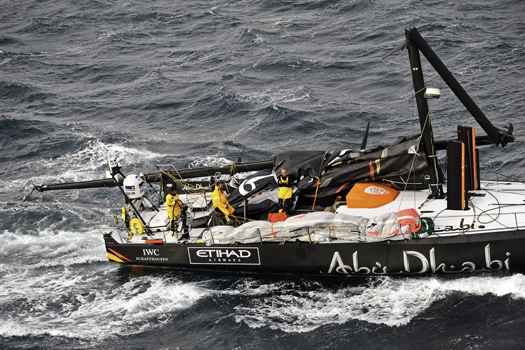
A first leg disaster for Ian Walker on Abu Dhabi - Photo: Paul Todd
The broken mast pieces and rig were recovered, thanks to the "courageous" intervention of crewman Wade Morgan, who entered the water to cut away the top of the mainsail.
Walker added: “The mast from the first spreader up is now secured to the port side of the boat. About three or four metres protrude from behind the boat. A spider web of lines is keeping the operation intact. The crew are deeply disappointed.”
Yacht and crew - which includes Wexford man Justin Slattery - were last night headed towards the flatter water at Cabo de Palos before returning to Alicante under motor to begin repairs and get back in the race.
Abu Dhabi Ocean Racing are one of six teams competing in the epic round-the-world yacht race, which is set to finish in Galway next July.
Earlier this week the team finished first in the initial in-port race of the competition.
The official Volvo Ocean Race website has more on the story HERE.
Legends on Show in Alicante, Photos by Rick Tomlinson HERE!
#LEGENDS REGATTA –This week's 16-boat 'legend' fleet racing in Alicante is a far throw from the six-pro teams waiting for this weekend's VOR start proper but everyone in the Spanish port knows that it is the cross-section of old ketches to International Offshore Rule (IOR) designs and right up to the 70-foot sleds of the present era is what has given birth to the modern €10 million race.
Ireland is featuring prominently in this 'oldies' race. Although there's no sign of NCB Ireland from 25 years ago there's plenty of Irish sailors in attendance for a proper celebration with Joe English, Harry Cudmore, Killian Bushe, Bob McCarthy and Enda O'Coineen leading the charge.
Rick Tomlinson's stunning photos of the Legend's regatta are below.
Galway's 2012 VOR Stopover Will Be 'Bigger and Better'
#VOLVO OCEAN RACE - Organisers for next year's Volvo Ocean Race stopover in Galway have promised the event will be "bigger and better" than the previous race visit in 2009.
John Killeen, president of Let's Do It Galway, told the Galway Independent that he expects as many as 8,000 foreign visitors to the City of the Tribes next July.
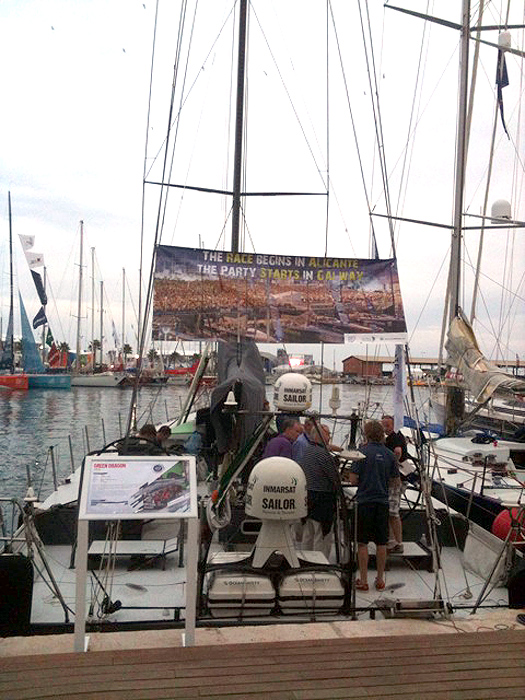
Green Dragon on show in Alicante this week – her dockside poster reads: 'the race begins in Alicante, the party starts in Galway'
Killeen is in Alicante on the Spanish Mediterranean for the week of events and in-port races leading up to the official start of the 2011-12 Volvo Ocean Race this Saturday.
The race is set to finish in Galway on Tuesday 3 July 2012, attracting the world's media to Ireland's fifth largest city for the final prize-giving.
Nimmo's Pier will be the focus of entertainment facilities for the many thousands expected to throng the city as the six competing yachts complete their epic challenge.
"It’s a rare opportunity for Galway and Ireland to have the leverage of such an event and, if we don’t [use it to benefit Galway], it will be remissible,” said Killeen.
The Galway Independent has more on the story HERE.
Volvo Ocean Race to Start in Alicante Again in 2014
# VOLVO OCEAN RACE The 12th edition of the Volvo Ocean Race will take place in 2014-15, starting once again in Alicante, after Volvo Car Corporation and Volvo Group reaffirmed their long-term commitment to the world's premier offshore sailing event but there is so far no news of the next course, other port stop overs or if the race will end in Galway in 2015.
Stefan Jacoby, CEO and President of Volvo Car Corporation, Olof Persson, CEO and President of Volvo Group and Knut Frostad, CEOof the Volvo Ocean Race. PAUL TODD/Volvo Ocean Race
"At a time when many sports events are struggling to survive in one of the toughest economic climates in living memory, the future of the Volvo Ocean Race is looking very healthy." - Volvo Ocean Race CEO Knut Frostad
Volvo Ocean Race CEO Knut Frostad announced the broad timetable just as the fleet prepared for the start of the 2011-12 edition in the Spanish port.
Flanked by Volvo Car Corporation CEO Stefan Jacoby and Volvo Group CEO Olof Persson, Frostad said the next race would begin in the autumn of 2014 in Alicante, where the race has been based since 2010.
Frostad's announcement came after the Volvo Ocean Race revealed that a record 66 broadcasters around the world have so far signed up to follow the 11th edition, reaching 550 million households.
"Right now, I'm concentrating on 2011-12 which I believe will be the most thrilling we've ever had," Frostad said. "I'm just excited that this race just keeps getting better and better in every aspect.
"We intend to bring the drama of a race which stretches its competitors to breaking point day in day out to a far bigger audience than ever before. We believe we will win new converts to this great sport of ours with our coverage."




























